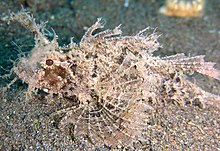| Pteroidichthys amboinensis | |
|---|---|

| |
| Conservation status | |
 Least Concern (IUCN 3.1) | |
| Scientific classification | |
| Domain: | Eukaryota |
| Kingdom: | Animalia |
| Phylum: | Chordata |
| Class: | Actinopterygii |
| Order: | Perciformes |
| Family: | Scorpaenidae |
| Genus: | Pteroidichthys |
| Species: | P. amboinensis |
| Binomial name | |
| Pteroidichthys amboinensis Bleeker, 1856 | |
| Synonyms | |
| |
Pteroidichthys amboinensis, the Ambon scorpionfish or Godfrey's scorpionfish, is a species of marine ray-finned fish belonging to the family Scorpaenidae, the scorpionfishes. It is found in the Indian and Pacific oceans.
Taxonomy
Pteroidichthys amboinensis was first formally described in 1856 by the Dutch herpetologist, ichthyologist and physician Pieter Bleeker with the type localities give as Ambon Island in the Moluccas and Manodo on Sulawesi. When Bleeker described this species he classified it in a new genus, Pteroidichthys, as the only species in the new genus making it the type species of that genus by monotypy. In 1954 the Australian ichthyologist Gilbert Percy Whitley described a new species as Rhinopias godfreyi from Exmouth Gulf in Western Australia but this taxon is now considered to be a junior synonym of P. amboinensis, however, this species is still called Godfrey's scorpionfish in Australia. The specific name refers to the type locality of Ambon Island.
Description
Pteroidichthys amboinensis has the elongate, compressed body typical of the genus Pteroidichthys. This species has 12 flexible spines and 9 soft rays in its dorsal fin and 2 spines and 6 soft rays in its anal fin. It has a relatively short snout which is on average around 14% of its standard length. The rear margin of the maxilla extends past a vertical line through the centre of the pupil. There are supraorbital tentacles and the posterior lacrimal spines are well developed, being longer than the diameter of the orbit. There are many tentacles on the body and the fins. The lateral lacrimal and suborbital spines are indistinct, normally being very small spines and frequently being blunt, bony protuberances. There is no clear black blotch on the soft rayed part of the dorsal fin. These fish sometimes have a mottled blackish and reddish colour, but they can make wide changes to their colour and pattern. | This species attains a maximum known total length of 12 cm (4.7 in).

Distribution and habitat
Pteroidichthys amboinensis is found in the Red Sea, through the Indian Oceamnand into the western Pacific Ocean as far east as Fiji, north to southern Japan and south to Australia. This is a demersal fish which is found at depths between 7 and 43 m (23 and 141 ft), over soft substrates and among algae.
Biology
Pteroidichthys amboinensis is a solitary ambush predator which is camouflaged to blend in to its habitat,feeding on crustaceans and small fish. This fish has venom bearing spines and the venom is highly toxic and, in some circumstances, invenomation can be fatal to humans.
Utilisation
Pteroidichthys amboinensis is a popular species in the aquarium trade but it is rare and as a result commands high prices.
References
- ^ Motomura, H. & Matsuura, K. (2016). "Pteroidichthys amboinensis". IUCN Red List of Threatened Species. 2016: e.T69798967A69801012. doi:10.2305/IUCN.UK.2016-3.RLTS.T69798967A69801012.en. Retrieved 18 November 2021.
- ^ Froese, Rainer; Pauly, Daniel (eds.). "Pteroidichthys amboinensis". FishBase. August 2021 version.
- Eschmeyer, William N.; Fricke, Ron & van der Laan, Richard (eds.). "Species in the genus Pteroidichthys". Catalog of Fishes. California Academy of Sciences. Retrieved 26 January 2022.
- Eschmeyer, William N.; Fricke, Ron & van der Laan, Richard (eds.). "Genera in the family Scorpaenidae". Catalog of Fishes. California Academy of Sciences. Retrieved 26 January 2022.
- ^ Motomura, H. & Kanade, Y. (2015). "Review of the scorpionfish genus Pteroidichthys (Scorpaenidae), with descriptions of two new species". Zootaxa. 4057 (4): 490–510. doi:10.11646/zootaxa.4057.4.2.
- ^ Dianne J. Bray. "Pteroidichthys amboinensis". Fishes of Australia. Museums Victoria. Retrieved 27 January 2022.
- Christopher Scharpf & Kenneth J. Lazara, eds. (2 October 2021). "Order Perciformes (Part 9): Suborder Scorpaenoidei: Family Scorpaenidae". The ETYFish Project Fish Name Etymology Database. Christopher Scharpf and Kenneth J. Lazara. Retrieved 26 January 2022.
- Dianne J. Bray. "Pteroidichthys". Fishes of Australia. Museums Victoria. Retrieved 27 January 2022.
- Bob Goemans (2012). "Pteroidichthys amboinensis". Saltcorner. Bob Goemans.
- Fricke, Ronald; Golani, Daniel & Appelbaum-Golani, Brenda (2015). "Confirmed record of the Ambon scorpionfish, Pteroidichthys amboinensis from the Red Sea (Teleostei: Scorpaenidae)". Marine Biodiversity Records. 8 (e113). doi:10.1017/S1755267215000949.
- "Ambon Scorpionfish (Pteroidichthys amboinensis)". whatsthatfish.com. Retrieved 26 January 2022.
- "Pteroidichthys amboinensis Ambon scorpionfish". Reeflex.com. Retrieved 26 January 2022.
External links
 Media related to Pteroidichthys amboinensis at Wikimedia Commons
Media related to Pteroidichthys amboinensis at Wikimedia Commons- Photos of Pteroidichthys amboinensis on Sealife Collection